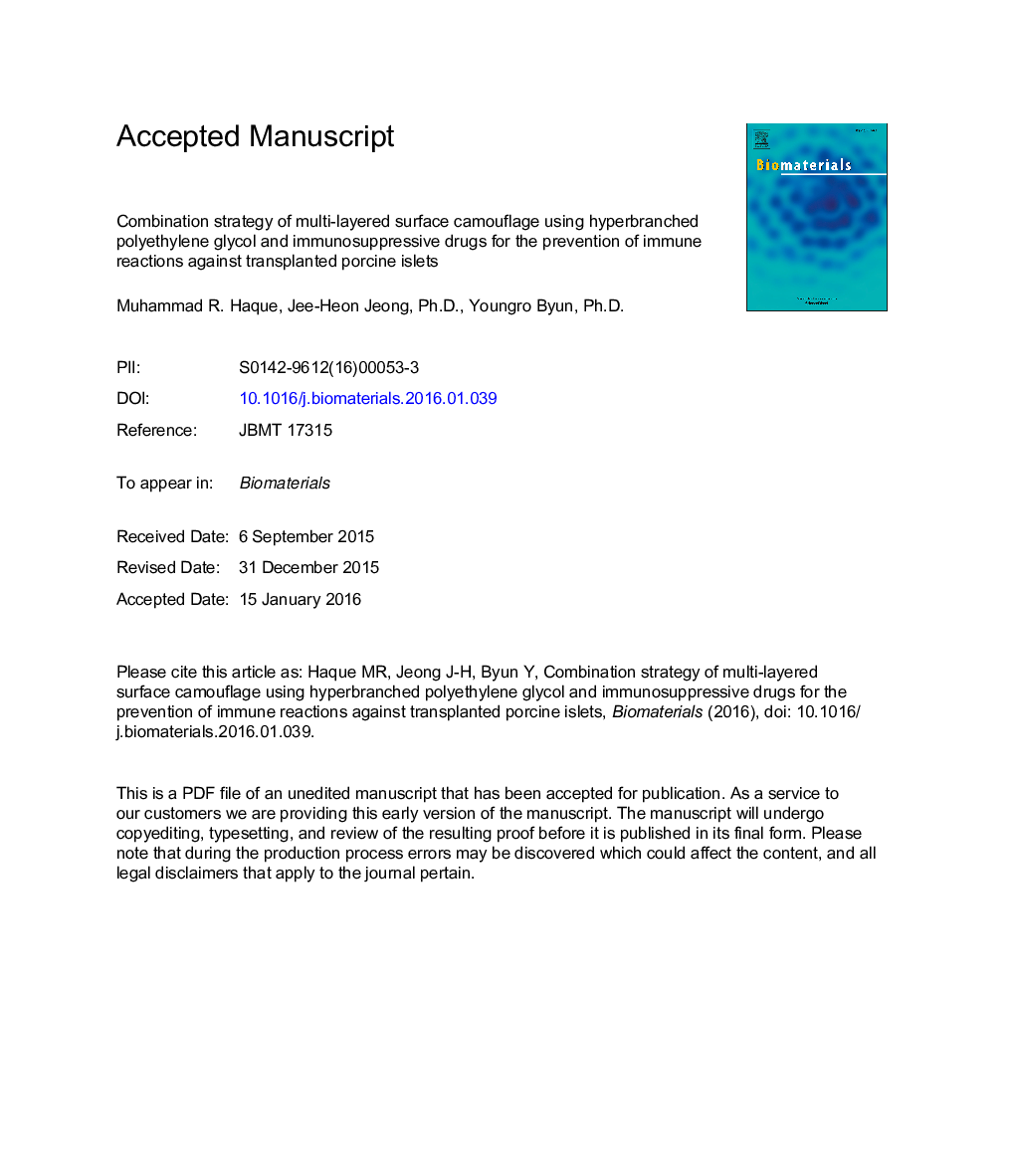| کد مقاله | کد نشریه | سال انتشار | مقاله انگلیسی | نسخه تمام متن |
|---|---|---|---|---|
| 6485105 | 382 | 2016 | 45 صفحه PDF | دانلود رایگان |
عنوان انگلیسی مقاله ISI
Combination strategy of multi-layered surface camouflage using hyperbranched polyethylene glycol and immunosuppressive drugs for the prevention of immune reactions against transplanted porcine islets
ترجمه فارسی عنوان
استراتژی ترکیبی استتار چند لایه ای با استفاده از پلی اتیلن گلیکول فشرده و داروهای ضد سرطان برای جلوگیری از واکنش های ایمنی در مقابل جزایر کبدی پیوند
دانلود مقاله + سفارش ترجمه
دانلود مقاله ISI انگلیسی
رایگان برای ایرانیان
موضوعات مرتبط
مهندسی و علوم پایه
مهندسی شیمی
بیو مهندسی (مهندسی زیستی)
چکیده انگلیسی
This study suggests a novel method of stabilizing fragile porcine islets to prevent the dissociation after isolation and reducing immune cell invasion in a combination therapy of 'surface camouflaging' and immunosuppressive drugs (FK506, Rapamycin, MR-1, anti-CD19 mAb, and Clodrosome®) to effectively alleviate overall immune reactions against xenotransplanted porcine islets. The surface camouflage of pancreatic islets using biocompatible materials improved stabilization of pancreatic islet and prevented the infiltration of immune cells. Firstly, the surface of porcine islets was camouflaged by SH-6-arm-PEG-lipid and gelatin-catechol (artificial extracellular matrix) in order to stabilize the fragile isolated islets. Secondly, three different PEG layers (6-arm-PEG-SH, 6-arm-PEG-catechol, and linear PEG-SH) were chemically conjugated onto the surface of the stabilized porcine islets. Both artificial extracellular matrix (artificial ECM) and PEGylation effectively covered the surface of porcine islets without increasing the size of the whole islet. In addition, the viability and functionality of the islets were not affected by this multi-layer surface modification. The multi-layer modification significantly reduced the attachment of human serum albumin, fibronectin, and immunoglobulin G in comparison to the control collagen surface. The combination effect of multi-layer PEGylation and cocktailed immunosuppressive drugs on the survival time of the transplanted islets was assessed in a xenogeneic porcine-to-mouse model. The median survival time (MST) of 'artificial ECM + PEGylation' group was 4-fold increased compared to that of control group. In addition, the MST of 'artificial ECM + PEGylation + drug' group was 2.16-fold increased, compared to the 'control + drug' group. In conclusion, we proposed a novel porcine islet transplantation protocol using surface multi-layer modification and cocktailed immunosuppressive drugs, for stabilization and immunoprotection against xenogeneic immune reactions.
ناشر
Database: Elsevier - ScienceDirect (ساینس دایرکت)
Journal: Biomaterials - Volume 84, April 2016, Pages 144-156
Journal: Biomaterials - Volume 84, April 2016, Pages 144-156
نویسندگان
Muhammad R. Haque, Jee-Heon Jeong, Youngro Byun,
